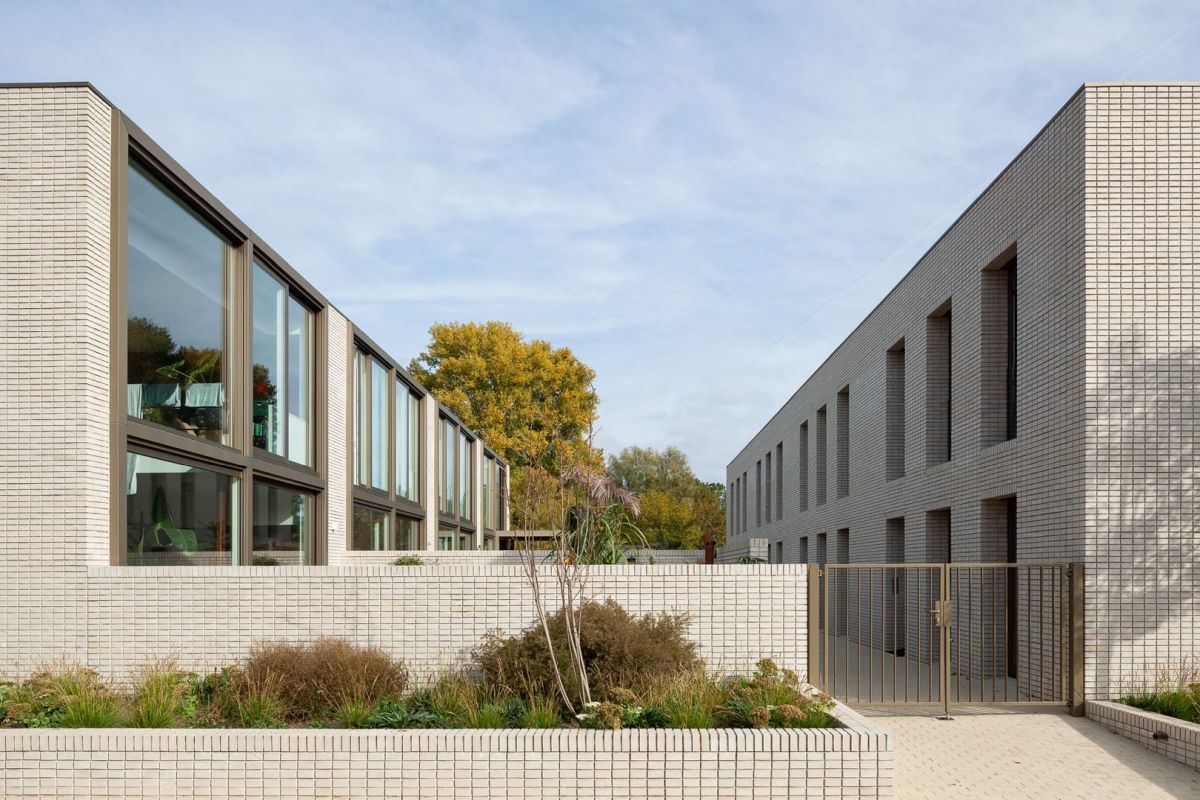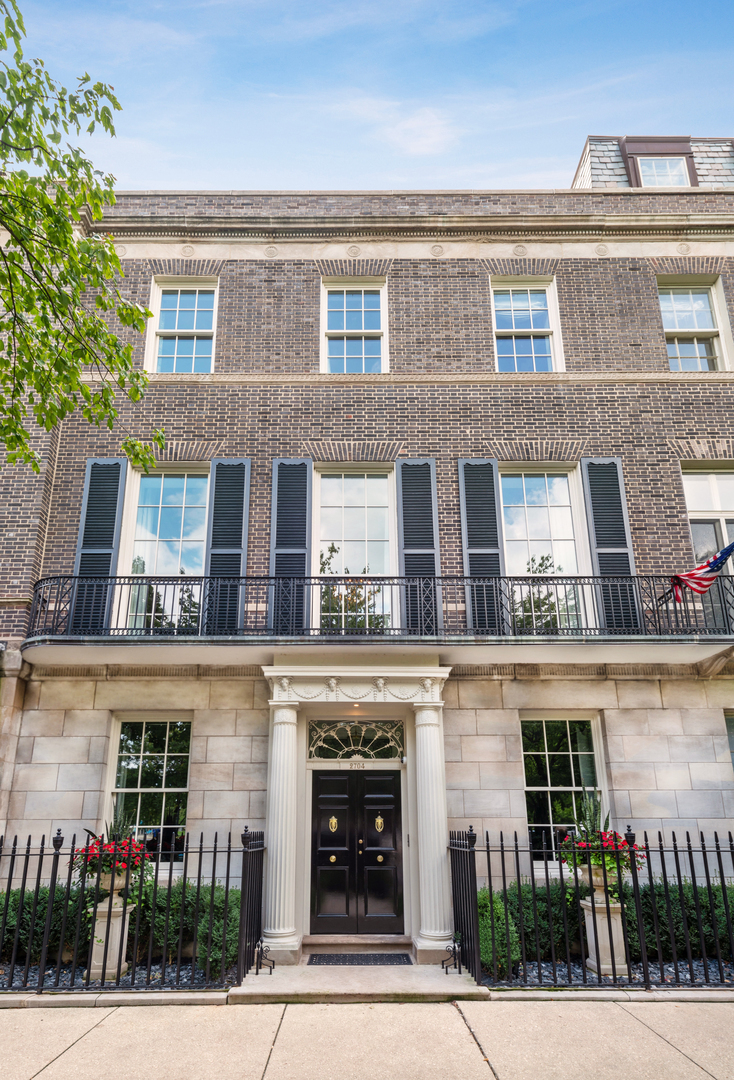A row house is a common architectural style found in large historic cities throughout the world. While it has origins as low-budget housing, row houses have a particular and unique style that is beloved by many home buyers.

On Realtor.com, Daniela Sassoun says that “row homes are one of the most desired pieces of real estate available”. This is most true in cities with charming historic districts like New York and Boston where row homes are most plentiful.
What is a Row House?
The row house is also called a rowhouse or terraced house. Builders constructed this particular home style with other homes of the same type each sharing the same side walls. They also shared the same roof line. They were valued because of the lower construction costs and the smaller land space needed for individual units.
Origins of Row Houses
Row housing originated in Belgium and the Netherlands in the 16th century. They came to London and Paris in the 17th century. The row house first came to the city of Philadelphia in the 1700s. After this, row homes appeared in the U.S. in other popular urban centers like New York, Boston, and Baltimore.
Architects designed row houses to provide low cost housing to the burgeoning middle-class working family. This was a step up from other low-cost construction like railroad apartments built for the same purpose. These row house districts developed a unique character and history in each city.
Row houses also appealed to the upper middle class in a way that smaller apartments did not. Row houses, and their fancier cousin the townhouse, were a way that wealthier people could enjoy a home in the city as well as in more rural districts. Row houses in wealthier districts enjoyed more decorative design styles. This adaptable nature is one of the reasons that the row house has endured over time.
Row House Architecture
Row house characteristics are common design features which make them a recognizable style and type.
- Height – Most row houses are between 2-5 stories high.
- Uniform Style – Row homes share similar external architectural characteristics like window type and moldings. Modern homeowners may differentiate their homes with unique paint and design elements.
- Individual Entrance – Row homes each had their own entrance, unlike apartment buildings. Subdivided row homes that investors have converted into apartments share the same entrance.
- Connection – Row homes are connected to the others using the same side walls and sharing the same roofline.
- Windows – Row homes do not have side windows but front and rear windows.
Row House Styles
There are several common row house styles as well as variations on these themes. Here are some of the most popular row house styles that you will encounter.
- Italianate – Row homes that are two-four stories high, many with brownstone facades. These have bold projecting forms like cornices and repetitive forms.
- Federal – Modest and simple style homes with brick facades and metal or slate roofs, wrought iron handrails, and wood paneled doors.
- Greek Revival – Simple lines with bold architectural features that mimic ancient Greek motifs, prominent columns and grand entrances.
- Victorian – Row homes with a high pitched roof and gable trim, bright painted colors and colorful stained glass.
- Georgian – Row homes that are brick with large windows and an entrance at the street level.
Pros and Cons of Row Houses
There are some who value the historic character and bustling neighborhood where you find typical row homes. Consider these important pros and cons before you make the decision to invest in a row house.
Pros
- Cost – Row houses are cost effective and offer some of the same amenities of single-family homes.
- Maintenance – Row homes are easier to maintain than single family homes because the yards are smaller and owners share some of the maintenance costs with each other.
- Privacy – Rowhomes offer more opportunity for privacy than other types of shared housing like apartments. These include private yard spaces and unshared floors and ceilings.
- Sustainability – Row homes are a more sustainable type of living than single family homes because the same number of people can occupy less ground space.
- Community – Row homes are an important part of many communities. They form a stabilizing influence to help ensure the future success of the community.
Cons
- Narrow Layout – Many row homes were built when home expectations were smaller in size. This narrow layout can be a challenge for a large family to navigate.
- Privacy – Row homes offer less privacy than stand-alone homes.
- Parking – Row homes have limited parking. This is a challenge with families that have driving children or where row homes have been converted to multi-living spaces.
- HOA Fees – The HOA fees for row home communities can be pricey. These include shared expenses for yard and exterior maintenance.
Modern and Historic Row House Districts
There are many historic row home districts spread throughout the world. Here are some of the most famous.
Remsen Street, Brooklyn Heights – New York, NY

The brownstones in Brooklyn are some of the most famous and historic row houses of today. They feature facades of New England sandstone with a deep rich color. These brownstones feature the Italianate style that was popular from 1840-1870.
Spijkerkwartier – Arnhem, Netherlands

This is a unique row home development from Atelier Kempe Thill. They seek to maximize the number of people who can have private dwellings in an urban context. The shared garden areas allow the inhabitants to function also as a community rather than as just individual units.
Lakeview Avenue Georgian Row Houses – Chicago, IL

This is a set of four Georgian style row homes. Henry Corwith Dangler and David Adler designed these row homes for some of their close friends who were prominent artists, architects, and designers in the city. These row homes have a unique style, but the architects designed them to resemble London-style townhomes.
Rainbow Row – Charleston, S.C.

Rainbow row is a group of 13 homes located in Charleston’s historic district. Merchants built them in the 18th century and used them as both shops and homes. They suffered decline after the Civil War which lasted until the 1920s and 1930s when some local women became invested in the area. One woman, Dorothy Legge painted her home a bright pink and the trend caught on in the area.
Real De Los Reyes 138 – Coyoacan, Mexico

For this row housing development, the architect Miguel De La Torre was interested in creating a traditional character. This meant using the deep orange concrete building materials that blended with the surrounding environment. Each home connects to a central courtyard and has an inner courtyard with the concrete lattice to provide privacy.
Frequently Asked Questions (FAQ)FAQ
What is the Row House of Tadao Ando?
This is a famous home built by Tadao Ando. It is situated in Osaka, Japan. It has no exterior windows. It is also called Azuma House.
What is a rowhouse vs townhouse?
A row house and townhouse are similar in construction. They both feature shared walls. In general, row houses are more simple in style than townhouses. Townhouses can feature exterior elements that make the design of the house unique from the surrounding houses. Row houses have a more similar exterior style to those in the group.
What do some row house membership costs include?
In most cases, the HOA fees include the service and maintenance of common areas like the landscaping and signage. For some row home communities, this can also mean areas like a clubhouse and a pool.
Are row houses a good investment?
Yes, row houses make excellent investments. They are prized by other home buyers and they help areas in the community by keeping the investment and interest high. They are a more sustainable way to live, so people who are eco-conscious love row homes. Many row homes are also historic properties, so there is increased interest in renovation and restoration of these homes.
Conclusion
Row houses are a popular historic and modern housing unit for urban areas throughout the world. The building style is a good way to reduce costs, increase efficiency, and create a greater sense of community. Interest in row homes continues to grow. They are amazing investment opportunities for first-time home buyers, those looking to downsize, or anyone who wants to live with a smaller footprint.
The post Row House Design: The Origins and Variety of This Unique Home Style appeared first on Homedit.
0 Commentaires